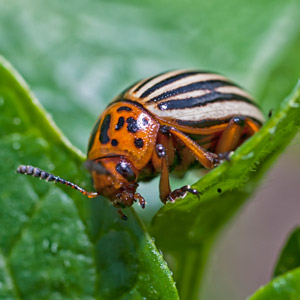Biorational Pesticides: Germs, worms, and Carnivorous fungi?
By Chris Williams on February 13, 2014.
Microbial insecticides are great low-impact tools for use in insect control and have found their way into many pest management programs. The premier biological agent with widespread use in agriculture is Bacillus thuringiensis (Bt). It was discovered back in the early part of the 20th century and formulations of it for insect control (mainly caterpillar control on food crops) have been in use since the 30’s so it’s been around a while.

The Colorado Potato Beatle
It was during the late 50’s that the actual mode of action of Bt was discovered. After a susceptible insect ingests the Bt, toxic proteins are produced which quickly destroy the lining of the gut. Several different strains have been identified/developed over the years to combat other insects like mosquitoes, leaf and needle feeding caterpillars, and a promising new one for control of Colorado potato beetle.
Another low impact biologic pesticide that has also been around for decades is Milky spore disease. Bacillus poplliae is another alternative choice to materials like imidicloprid or bifenthrin for white grub control in turf grass. I’ve never personally had much success with it, because it is slow acting and I probably never gave it a chance to build up in my yard enough for continuous control. It is expensive also which adds to the downside for me.
Spinosad is a fairly recent discovery and entirely new class of insecticide derived (through fermentation) from the soil-borne microbe Saccharopolyspora spinosa. Spinosad affects the insect’s central nervous system and works mostly through ingestion and some contact activity. Several commercial products have been developed for the professional grower and back yard gardener. To date, I’ve not seen any spinosad containing products aimed at the urban pest control market.
Now, we’ll look a bit into worms for pest control, but just a bit, because entomopathogenic nematodes are pretty tricky to use. These microscopic round worms do attack white grubs and some caterpillars, but the difficulty manufacturers have in mass rearing them and keeping them viable (very short shelf life), ultimately make them impractical to use.
Lastly, there is an entomophagous (insect eating!) fungus called Beauveria bassiana which attacks a wide variety of pests from Japanese beetle to termites and European corn borer to chinch bugs. This naturally occurring soil borne fungus is now mass-produced through fermentation process and available in products with the trade names like Naturalis and Mycotrol. Once again, these products have found a home in organic agriculture and as of yet there are none out there for urban pest control.